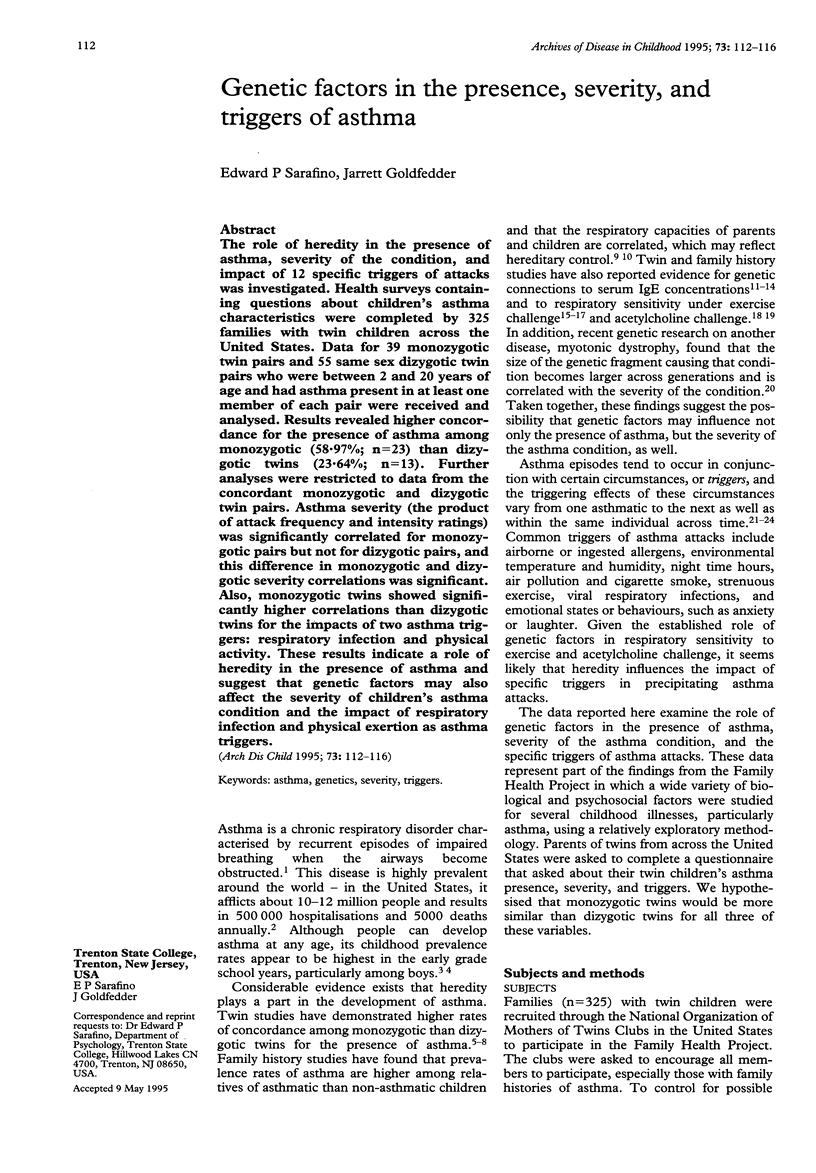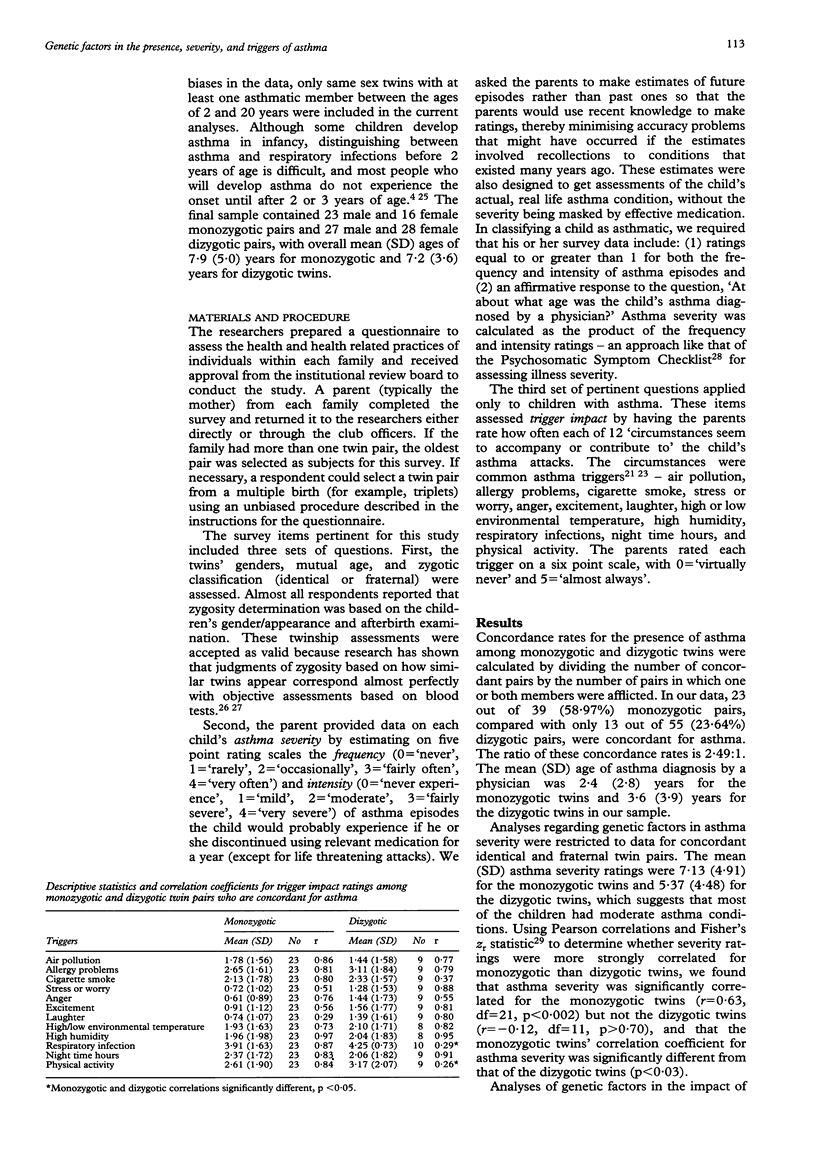Abstract
The role of heredity in the presence of asthma, severity of the condition, and impact of 12 specific triggers of attacks was investigated. Health surveys containing questions about children's asthma characteristics were completed by 325 families with twin children across the United States. Data for 39 monozygotic twin pairs and 55 same sex dizygotic twin pairs who were between 2 and 20 years of age and had asthma present in at least one member of each pair were received and analysed. Results revealed higher concordance for the presence of asthma among monozygotic (58.97%; n = 23) than dizygotic twins (23.64%; n = 13). Further analyses were restricted to data from the concordant monozygotic and dizygotic twin pairs. Asthma severity (the product of attack frequency and intensity ratings) was significantly correlated for monozygotic pairs but not for dizygotic pairs, and this difference in monozygotic and dizygotic severity correlations was significant. Also, monozygotic twins showed significantly higher correlations than dizygotic twins for the impacts of two asthma triggers: respiratory infection and physical activity. These results indicate a role of heredity in the presence of asthma and suggest that genetic factors may also affect the severity of children's asthma condition and the impact of respiratory infection and physical exertion as asthma triggers.
Full text
PDF




Selected References
These references are in PubMed. This may not be the complete list of references from this article.
- Backer V., Ulrik C. S., Hansen K. K., Laursen E. M., Dirksen A., Bach-Mortensen N. Atopy and bronchial responsiveness in random population sample of 527 children and adolescents. Ann Allergy. 1992 Aug;69(2):116–122. [PubMed] [Google Scholar]
- Burney P., Chinn S. Developing a new questionnaire for measuring the prevalence and distribution of asthma. Chest. 1987 Jun;91(6 Suppl):79S–83S. doi: 10.1378/chest.91.6_supplement.79s. [DOI] [PubMed] [Google Scholar]
- Burrows B., Martinez F. D., Halonen M., Barbee R. A., Cline M. G. Association of asthma with serum IgE levels and skin-test reactivity to allergens. N Engl J Med. 1989 Feb 2;320(5):271–277. doi: 10.1056/NEJM198902023200502. [DOI] [PubMed] [Google Scholar]
- Busse W. W. Respiratory infections: their role in airway responsiveness and the pathogenesis of asthma. J Allergy Clin Immunol. 1990 Apr;85(4):671–683. doi: 10.1016/0091-6749(90)90181-3. [DOI] [PubMed] [Google Scholar]
- Chibnall J. T., Tait R. C. The Psychosomatic Symptom Checklist revisited: reliability and validity in a chronic pain population. J Behav Med. 1989 Jun;12(3):297–307. doi: 10.1007/BF00844873. [DOI] [PubMed] [Google Scholar]
- Cropp G. J. Special features of asthma in children. Chest. 1985 Jan;87(1 Suppl):55S–62S. doi: 10.1378/chest.87.1.55S. [DOI] [PMC free article] [PubMed] [Google Scholar]
- Dold S., Wjst M., von Mutius E., Reitmeir P., Stiepel E. Genetic risk for asthma, allergic rhinitis, and atopic dermatitis. Arch Dis Child. 1992 Aug;67(8):1018–1022. doi: 10.1136/adc.67.8.1018. [DOI] [PMC free article] [PubMed] [Google Scholar]
- Duffy D. L., Martin N. G., Battistutta D., Hopper J. L., Mathews J. D. Genetics of asthma and hay fever in Australian twins. Am Rev Respir Dis. 1990 Dec;142(6 Pt 1):1351–1358. doi: 10.1164/ajrccm/142.6_Pt_1.1351. [DOI] [PubMed] [Google Scholar]
- Edfors-Lubs M. L. Allergy in 7000 twin pairs. Acta Allergol. 1971 Aug;26(4):249–285. doi: 10.1111/j.1398-9995.1971.tb01300.x. [DOI] [PubMed] [Google Scholar]
- Gergen P. J., Mullally D. I., Evans R., 3rd National survey of prevalence of asthma among children in the United States, 1976 to 1980. Pediatrics. 1988 Jan;81(1):1–7. [PubMed] [Google Scholar]
- Harley H. G., Brook J. D., Rundle S. A., Crow S., Reardon W., Buckler A. J., Harper P. S., Housman D. E., Shaw D. J. Expansion of an unstable DNA region and phenotypic variation in myotonic dystrophy. Nature. 1992 Feb 6;355(6360):545–546. doi: 10.1038/355545a0. [DOI] [PubMed] [Google Scholar]
- Higgins M., Keller J. Familial occurrence of chronic respiratory disease and familial resemblance in ventilatory capacity. J Chronic Dis. 1975 Apr;28(4):239–251. doi: 10.1016/0021-9681(75)90053-3. [DOI] [PubMed] [Google Scholar]
- Hopp R. J., Bewtra A. K., Watt G. D., Nair N. M., Townley R. G. Genetic analysis of allergic disease in twins. J Allergy Clin Immunol. 1984 Feb;73(2):265–270. doi: 10.1016/s0091-6749(84)80018-4. [DOI] [PubMed] [Google Scholar]
- Hopper J. L., Hannah M. C., Macaskill G. T., Mathews J. D. Twin concordance for a binary trait: III. A bivariate analysis of hay fever and asthma. Genet Epidemiol. 1990;7(4):277–289. doi: 10.1002/gepi.1370070406. [DOI] [PubMed] [Google Scholar]
- Janson-Bjerklie S., Carrieri V. K., Hudes M. The sensations of pulmonary dyspnea. Nurs Res. 1986 May-Jun;35(3):154–159. [PubMed] [Google Scholar]
- Kasriel J., Eaves L. The zygosity of twins: further evidence on the agreement between diagnosis by blood groups and written questionnaires. J Biosoc Sci. 1976 Jul;8(3):263–266. doi: 10.1017/s0021932000010737. [DOI] [PubMed] [Google Scholar]
- König P., Godfrey S. Prevalence of exercise-induced bronchial lability in families of children with asthma. Arch Dis Child. 1973 Jul;48(7):513–518. doi: 10.1136/adc.48.7.513. [DOI] [PMC free article] [PubMed] [Google Scholar]
- Lee T. H. Precipitating factors of asthma. Br Med Bull. 1992 Jan;48(1):169–178. doi: 10.1093/oxfordjournals.bmb.a072532. [DOI] [PubMed] [Google Scholar]
- Leeder S. R., Corkhill R. T., Wysocki M. J., Holland W. W. Influence of personal and family factors on ventilatory function of children. Br J Prev Soc Med. 1976 Dec;30(4):219–224. doi: 10.1136/jech.30.4.219. [DOI] [PMC free article] [PubMed] [Google Scholar]
- Longo G., Strinati R., Poli F., Fumi F. Genetic factors in nonspecific bronchial hyperreactivity. An epidemiologic study. Am J Dis Child. 1987 Mar;141(3):331–334. doi: 10.1001/archpedi.1987.04460030109037. [DOI] [PubMed] [Google Scholar]
- Martinez F. D., Wright A. L., Taussig L. M., Holberg C. J., Halonen M., Morgan W. J. Asthma and wheezing in the first six years of life. The Group Health Medical Associates. N Engl J Med. 1995 Jan 19;332(3):133–138. doi: 10.1056/NEJM199501193320301. [DOI] [PubMed] [Google Scholar]
- Nieminen M. M., Kaprio J., Koskenvuo M. A population-based study of bronchial asthma in adult twin pairs. Chest. 1991 Jul;100(1):70–75. doi: 10.1378/chest.100.1.70. [DOI] [PubMed] [Google Scholar]
- Sarna S., Kaprio J., Sistonen P., Koskenvuo M. Diagnosis of twin zygosity by mailed questionnaire. Hum Hered. 1978;28(4):241–254. doi: 10.1159/000152964. [DOI] [PubMed] [Google Scholar]
- Sinha S. B., Yadav C. N. The asthmogenic effect of exercise stress on the normal first degree relatives of asthmatic subjects. Indian J Chest Dis Allied Sci. 1985 Jul-Sep;27(3):141–147. [PubMed] [Google Scholar]
- Sistonen P., Johnsson V., Koskenvuo M., Aho K. Serum IgE levels in twins. Hum Hered. 1980;30(3):155–158. doi: 10.1159/000153120. [DOI] [PubMed] [Google Scholar]
- Townley R. G., Southard J. G., Radford P., Hopp R. J., Bewtra A. K., Ford L. Association of MS Pi phenotype with airway hyperresponsiveness. Chest. 1990 Sep;98(3):594–599. doi: 10.1378/chest.98.3.594. [DOI] [PubMed] [Google Scholar]


